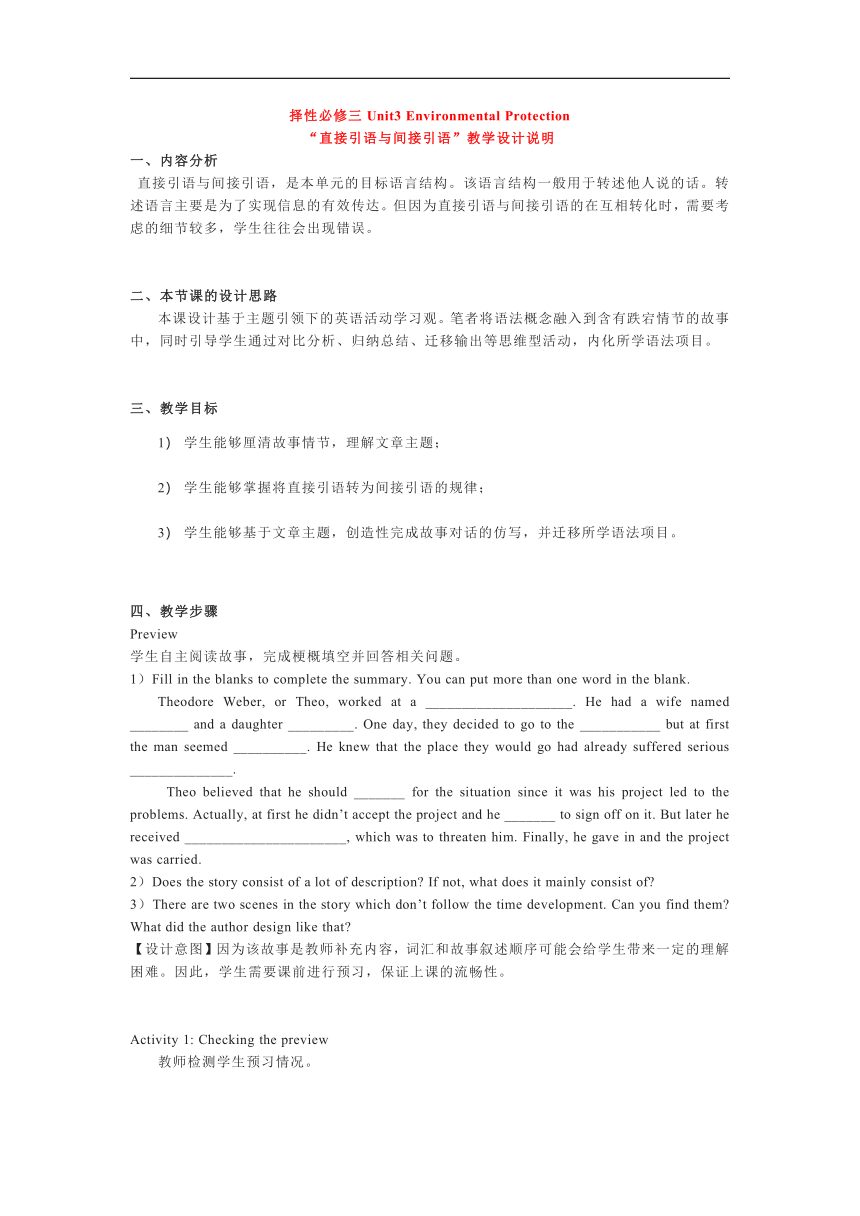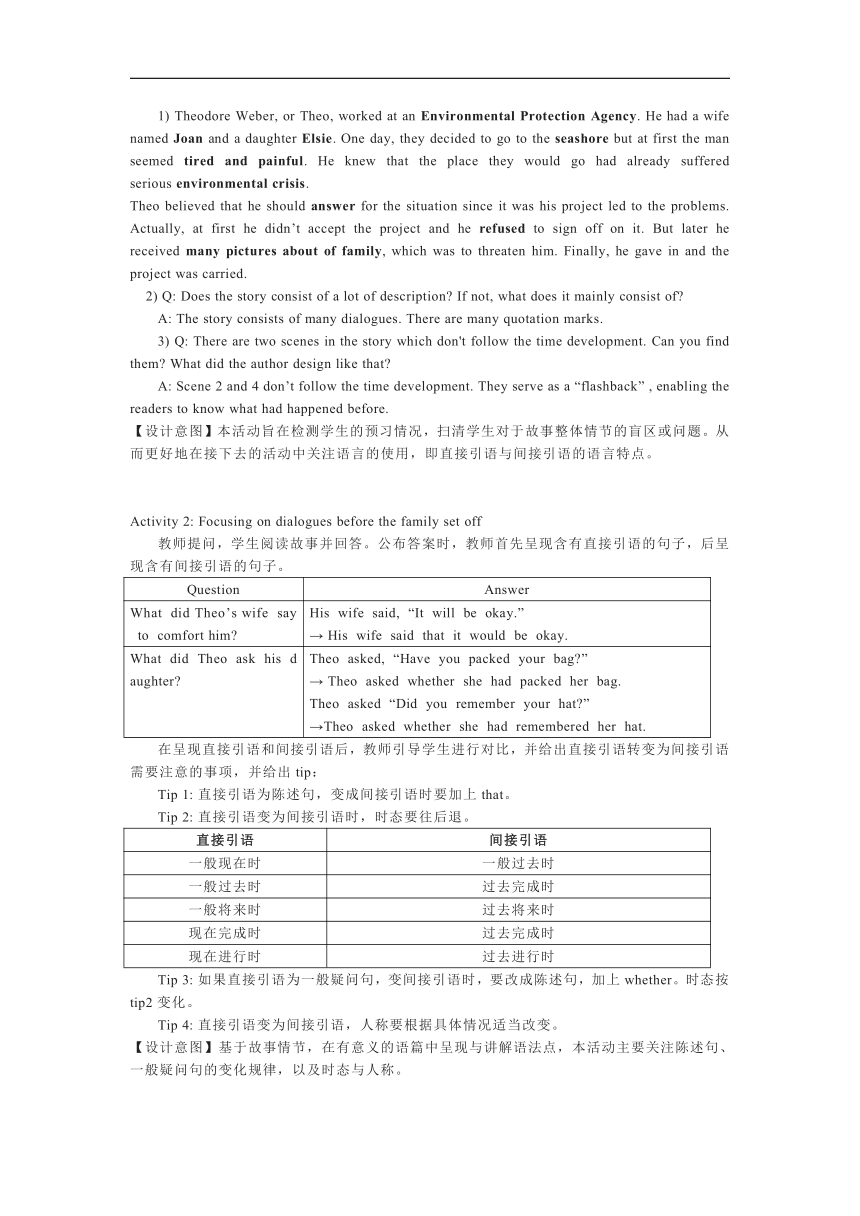人教版(2019) 选择性必修第三册 Unit 3 Environmental Protection “直接引语与间接引语”教学设计
文档属性
| 名称 | 人教版(2019) 选择性必修第三册 Unit 3 Environmental Protection “直接引语与间接引语”教学设计 |

|
|
| 格式 | docx | ||
| 文件大小 | 24.7KB | ||
| 资源类型 | 教案 | ||
| 版本资源 | 人教版(2019) | ||
| 科目 | 英语 | ||
| 更新时间 | 2022-10-28 23:49:34 | ||
图片预览


文档简介
择性必修三 Unit3 Environmental Protection
“直接引语与间接引语”教学设计说明
一、内容分析
直接引语与间接引语,是本单元的目标语言结构。该语言结构一般用于转述他人说的话。转述语言主要是为了实现信息的有效传达。但因为直接引语与间接引语的在互相转化时,需要考虑的细节较多,学生往往会出现错误。
二、本节课的设计思路
本课设计基于主题引领下的英语活动学习观。笔者将语法概念融入到含有跌宕情节的故事中,同时引导学生通过对比分析、归纳总结、迁移输出等思维型活动,内化所学语法项目。
三、教学目标
1) 学生能够厘清故事情节,理解文章主题;
2) 学生能够掌握将直接引语转为间接引语的规律;
3) 学生能够基于文章主题,创造性完成故事对话的仿写,并迁移所学语法项目。
四、教学步骤
Preview
学生自主阅读故事,完成梗概填空并回答相关问题。
1)Fill in the blanks to complete the summary. You can put more than one word in the blank.
Theodore Weber, or Theo, worked at a ____________________. He had a wife named ________ and a daughter _________. One day, they decided to go to the ___________ but at first the man seemed __________. He knew that the place they would go had already suffered serious ______________.
Theo believed that he should _______ for the situation since it was his project led to the problems. Actually, at first he didn’t accept the project and he _______ to sign off on it. But later he received ______________________, which was to threaten him. Finally, he gave in and the project was carried.
2)Does the story consist of a lot of description If not, what does it mainly consist of
3)There are two scenes in the story which don’t follow the time development. Can you find them What did the author design like that
【设计意图】因为该故事是教师补充内容,词汇和故事叙述顺序可能会给学生带来一定的理解困难。因此,学生需要课前进行预习,保证上课的流畅性。
Activity 1: Checking the preview
教师检测学生预习情况。
1) Theodore Weber, or Theo, worked at an Environmental Protection Agency. He had a wife named Joan and a daughter Elsie. One day, they decided to go to the seashore but at first the man seemed tired and painful. He knew that the place they would go had already suffered serious environmental crisis.
Theo believed that he should answer for the situation since it was his project led to the problems. Actually, at first he didn’t accept the project and he refused to sign off on it. But later he received many pictures about of family, which was to threaten him. Finally, he gave in and the project was carried.
2) Q: Does the story consist of a lot of description If not, what does it mainly consist of
A: The story consists of many dialogues. There are many quotation marks.
3) Q: There are two scenes in the story which don't follow the time development. Can you find them What did the author design like that
A: Scene 2 and 4 don’t follow the time development. They serve as a “flashback” , enabling the readers to know what had happened before.
【设计意图】本活动旨在检测学生的预习情况,扫清学生对于故事整体情节的盲区或问题。从而更好地在接下去的活动中关注语言的使用,即直接引语与间接引语的语言特点。
Activity 2: Focusing on dialogues before the family set off
教师提问,学生阅读故事并回答。公布答案时,教师首先呈现含有直接引语的句子,后呈现含有间接引语的句子。
Question Answer
What did Theo’s wife say to comfort him His wife said, “It will be okay.” → His wife said that it would be okay.
What did Theo ask his daughter Theo asked, “Have you packed your bag ” → Theo asked whether she had packed her bag. Theo asked “Did you remember your hat ” →Theo asked whether she had remembered her hat.
在呈现直接引语和间接引语后,教师引导学生进行对比,并给出直接引语转变为间接引语需要注意的事项,并给出tip:
Tip 1: 直接引语为陈述句,变成间接引语时要加上that。
Tip 2: 直接引语变为间接引语时,时态要往后退。
直接引语 间接引语
一般现在时 一般过去时
一般过去时 过去完成时
一般将来时 过去将来时
现在完成时 过去完成时
现在进行时 过去进行时
Tip 3: 如果直接引语为一般疑问句,变间接引语时,要改成陈述句,加上whether。时态按tip2变化。
Tip 4: 直接引语变为间接引语,人称要根据具体情况适当改变。
【设计意图】基于故事情节,在有意义的语篇中呈现与讲解语法点,本活动主要关注陈述句、一般疑问句的变化规律,以及时态与人称。
Activity 3: Focusing on dialogues after the family arrived
教师提问,学生阅读故事并回答,教师首先呈现含有直接引语的句子,后呈现含有间接引语的句子。
Question Answer
What was Joan’s advice when Elise said she wanted to go exploring Joan said, “Why don’t we go for a walk ” → Joan advised them to go for a walk.
What did Joan advise Elsie to do when Elise wanted to know what had happened before Joan said, “Why don’t you ask Dad ” → Joan advised Elise to ask Dad.
What did Elise ask her Dad And how did Theo reply “Daddy, where are all the people ” asked Elise. “They moved,” replied Theo. “Why did they move ” asked Elise. “There’s no sea anymore.” replied Theo. → Elise asked her daddy where were all the people. Theo said that they had moved. Elise asked why they had moved. Theo said that there was no sea anymore.
在呈现直接引语和间接引语后,教师引导学生进行对比,并给出直接引语转变为间接引语需要注意的事项,并给出tip。最后一问的答案呈现方式有所不同,改为教师先给出直接引语和tip6,再让学生根据tip6将其改成间接引语,学生口头表达即可。
Tip 5: 如果直接引语含有提建议的语气,或为祈使句,变间接引语时,动词根据语气可以选择tell, ask, order, advise等,使用tell/ask/order/advise sb. (not) to do的结构。
Tip6: 如果直接引语为特殊疑问句,变间接引语时,要改为陈述句,原疑问词保留。时态按tip2变化。
【设计意图】基于故事情节,在有意义的语篇中呈现与讲解语法点,本活动主要关注祈使句、带有建议语气的句子、特殊疑问句的变化规律。
Activity 4: Discussing the title
教师引导学生关注标题:Would you,并提问以下问题:
Q: Theo met the conflict between family protection and environmental protection. If you were Theo, what would you choose Why
Q: If you were Theo, what would you say to the people who had threatened you Write what you would say in direct speech and then change them into indirect speech.
【设计意图】本活动回归故事情节,讨论“标题引发的思考”,将所学语法项目进行迁移。
Assignment
Suppose two years later, Theo met a similar dilemma again: there was an important project that should be carried out at the cost of the environment of a local village. Please create a scene in which Theo and his wife talked with each other. Write in direct speech with more than 80 words and then change it into indirect speech.
【设计意图】本活动旨在利用本节课所学内容进行创新性迁移。学生需要结合故事情节、主题与人物关系,构建新场景。同时使用间接引语和直接引语将对话进行呈现,培养学生的创新思维。
五、本堂课设计亮点
学生通过阅读以“保护环境”为主题的故事,将“直接引语”与“间接引语”的语法概念融入到有声有色的故事情节中,并能够根据教师设计的任务,创造性地使用所学语法项目,结合故事情节、主题与人物关系来构建新场景、提升自身的创新思维。
“直接引语与间接引语”教学设计说明
一、内容分析
直接引语与间接引语,是本单元的目标语言结构。该语言结构一般用于转述他人说的话。转述语言主要是为了实现信息的有效传达。但因为直接引语与间接引语的在互相转化时,需要考虑的细节较多,学生往往会出现错误。
二、本节课的设计思路
本课设计基于主题引领下的英语活动学习观。笔者将语法概念融入到含有跌宕情节的故事中,同时引导学生通过对比分析、归纳总结、迁移输出等思维型活动,内化所学语法项目。
三、教学目标
1) 学生能够厘清故事情节,理解文章主题;
2) 学生能够掌握将直接引语转为间接引语的规律;
3) 学生能够基于文章主题,创造性完成故事对话的仿写,并迁移所学语法项目。
四、教学步骤
Preview
学生自主阅读故事,完成梗概填空并回答相关问题。
1)Fill in the blanks to complete the summary. You can put more than one word in the blank.
Theodore Weber, or Theo, worked at a ____________________. He had a wife named ________ and a daughter _________. One day, they decided to go to the ___________ but at first the man seemed __________. He knew that the place they would go had already suffered serious ______________.
Theo believed that he should _______ for the situation since it was his project led to the problems. Actually, at first he didn’t accept the project and he _______ to sign off on it. But later he received ______________________, which was to threaten him. Finally, he gave in and the project was carried.
2)Does the story consist of a lot of description If not, what does it mainly consist of
3)There are two scenes in the story which don’t follow the time development. Can you find them What did the author design like that
【设计意图】因为该故事是教师补充内容,词汇和故事叙述顺序可能会给学生带来一定的理解困难。因此,学生需要课前进行预习,保证上课的流畅性。
Activity 1: Checking the preview
教师检测学生预习情况。
1) Theodore Weber, or Theo, worked at an Environmental Protection Agency. He had a wife named Joan and a daughter Elsie. One day, they decided to go to the seashore but at first the man seemed tired and painful. He knew that the place they would go had already suffered serious environmental crisis.
Theo believed that he should answer for the situation since it was his project led to the problems. Actually, at first he didn’t accept the project and he refused to sign off on it. But later he received many pictures about of family, which was to threaten him. Finally, he gave in and the project was carried.
2) Q: Does the story consist of a lot of description If not, what does it mainly consist of
A: The story consists of many dialogues. There are many quotation marks.
3) Q: There are two scenes in the story which don't follow the time development. Can you find them What did the author design like that
A: Scene 2 and 4 don’t follow the time development. They serve as a “flashback” , enabling the readers to know what had happened before.
【设计意图】本活动旨在检测学生的预习情况,扫清学生对于故事整体情节的盲区或问题。从而更好地在接下去的活动中关注语言的使用,即直接引语与间接引语的语言特点。
Activity 2: Focusing on dialogues before the family set off
教师提问,学生阅读故事并回答。公布答案时,教师首先呈现含有直接引语的句子,后呈现含有间接引语的句子。
Question Answer
What did Theo’s wife say to comfort him His wife said, “It will be okay.” → His wife said that it would be okay.
What did Theo ask his daughter Theo asked, “Have you packed your bag ” → Theo asked whether she had packed her bag. Theo asked “Did you remember your hat ” →Theo asked whether she had remembered her hat.
在呈现直接引语和间接引语后,教师引导学生进行对比,并给出直接引语转变为间接引语需要注意的事项,并给出tip:
Tip 1: 直接引语为陈述句,变成间接引语时要加上that。
Tip 2: 直接引语变为间接引语时,时态要往后退。
直接引语 间接引语
一般现在时 一般过去时
一般过去时 过去完成时
一般将来时 过去将来时
现在完成时 过去完成时
现在进行时 过去进行时
Tip 3: 如果直接引语为一般疑问句,变间接引语时,要改成陈述句,加上whether。时态按tip2变化。
Tip 4: 直接引语变为间接引语,人称要根据具体情况适当改变。
【设计意图】基于故事情节,在有意义的语篇中呈现与讲解语法点,本活动主要关注陈述句、一般疑问句的变化规律,以及时态与人称。
Activity 3: Focusing on dialogues after the family arrived
教师提问,学生阅读故事并回答,教师首先呈现含有直接引语的句子,后呈现含有间接引语的句子。
Question Answer
What was Joan’s advice when Elise said she wanted to go exploring Joan said, “Why don’t we go for a walk ” → Joan advised them to go for a walk.
What did Joan advise Elsie to do when Elise wanted to know what had happened before Joan said, “Why don’t you ask Dad ” → Joan advised Elise to ask Dad.
What did Elise ask her Dad And how did Theo reply “Daddy, where are all the people ” asked Elise. “They moved,” replied Theo. “Why did they move ” asked Elise. “There’s no sea anymore.” replied Theo. → Elise asked her daddy where were all the people. Theo said that they had moved. Elise asked why they had moved. Theo said that there was no sea anymore.
在呈现直接引语和间接引语后,教师引导学生进行对比,并给出直接引语转变为间接引语需要注意的事项,并给出tip。最后一问的答案呈现方式有所不同,改为教师先给出直接引语和tip6,再让学生根据tip6将其改成间接引语,学生口头表达即可。
Tip 5: 如果直接引语含有提建议的语气,或为祈使句,变间接引语时,动词根据语气可以选择tell, ask, order, advise等,使用tell/ask/order/advise sb. (not) to do的结构。
Tip6: 如果直接引语为特殊疑问句,变间接引语时,要改为陈述句,原疑问词保留。时态按tip2变化。
【设计意图】基于故事情节,在有意义的语篇中呈现与讲解语法点,本活动主要关注祈使句、带有建议语气的句子、特殊疑问句的变化规律。
Activity 4: Discussing the title
教师引导学生关注标题:Would you,并提问以下问题:
Q: Theo met the conflict between family protection and environmental protection. If you were Theo, what would you choose Why
Q: If you were Theo, what would you say to the people who had threatened you Write what you would say in direct speech and then change them into indirect speech.
【设计意图】本活动回归故事情节,讨论“标题引发的思考”,将所学语法项目进行迁移。
Assignment
Suppose two years later, Theo met a similar dilemma again: there was an important project that should be carried out at the cost of the environment of a local village. Please create a scene in which Theo and his wife talked with each other. Write in direct speech with more than 80 words and then change it into indirect speech.
【设计意图】本活动旨在利用本节课所学内容进行创新性迁移。学生需要结合故事情节、主题与人物关系,构建新场景。同时使用间接引语和直接引语将对话进行呈现,培养学生的创新思维。
五、本堂课设计亮点
学生通过阅读以“保护环境”为主题的故事,将“直接引语”与“间接引语”的语法概念融入到有声有色的故事情节中,并能够根据教师设计的任务,创造性地使用所学语法项目,结合故事情节、主题与人物关系来构建新场景、提升自身的创新思维。
